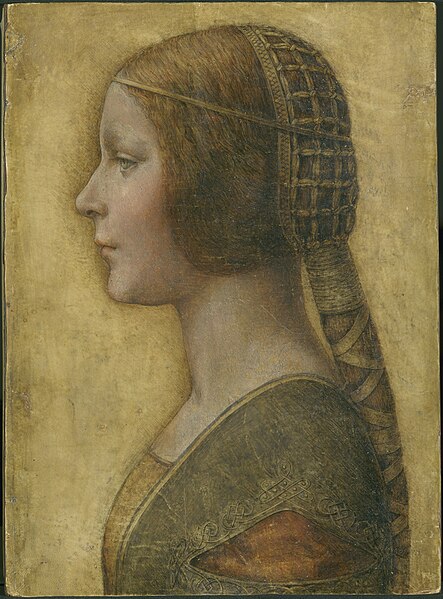La Bella Principessa, also known as Portrait of Bianca Sforza, Young Girl in Profile in Renaissance Dress and Portrait of a Young Fiancée, is a portrait in coloured chalks and ink, on vellum, of a young lady in fashionable costume and hairstyle of a Milanese of the 1490s. Some scholars have attributed it to Leonardo da Vinci but the attribution and the work's authenticity have been disputed. Supporters of the theory that it was by Leonardo have propositioned that Bianca Maria Sforza is the woman depicted in the drawing.
La Bella Principessa
A portrait by Ambrogio da Predis of Bianca Maria Sforza showing a similar hairstyle (National Gallery of Art)
Detail of the upper left corner, revealing a fingerprint which has been suggested as being similar to one of Leonardo's.
A page of La Sforziada from the National Library of Poland (Biblioteka Narodowa) in Warsaw
Bianca Maria Sforza was Queen of Germany and Empress of the Holy Roman Empire as the third spouse of Maximilian I. She was the eldest legitimate daughter of Duke Galeazzo Maria Sforza of Milan by his second wife, Bona of Savoy.
Portrait by Bernhard Strigel, ca. 1505/1510
Fresco of Empress Bianca Maria Palazzo degli Atellani [it] in Milan, early 16th century, by Bernardino Luini.
The Swarowski bust of Bianca Maria Sforza created by Tibor Bogdan
La Bella Principessa (1495)






![Fresco of Empress Bianca Maria Palazzo degli Atellani [it] in Milan, early 16th century, by Bernardino Luini.](https://upload.wikimedia.org/wikipedia/commons/thumb/a/a5/Bernardino_Luini_016.jpg/640px-Bernardino_Luini_016.jpg)
